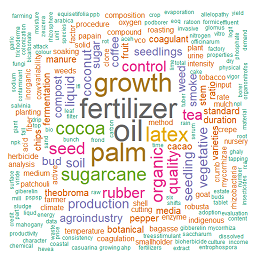Kajian Pengaruh Perbedaan Kerapatan Tanam dan Tahun Tanam terhadap Produktivitas Kelapa Sawit
DOI:
https://doi.org/10.25181/jaip.v11i3.3238Keywords:
agronomic characters, planting density, planting year, productivityAbstract
The oil palm yield depends on its genetic and the interaction with environmental factors is affected by spatial arrangement of palm trees. The research objectives are to determine the effect of population density and planting year on oil palm productivity and vegetative growth. This research uses a factorial design arranged with a randomized complete design. Secondary data are palm productivity, fresh bunch number and bunch weight that were collected for three years (2019—2022). Primary data are stem height, frond length, and stem gird which were measured on 90 trees for each treatment combination. There are nine combinations with 810 palm trees that were sampled from 27 estate blocks (30 hectares for one block). The results showed that productivity and amount of oil palm FFB at densities ≥ 142, 136-141, and ≤ 135 SPH and planting years 2007, 2009 and 2011 (mature crop 12-15, 10-13, and 8-11 years) did not show significant differences. The heavier bunch weight was produced palm tree planted in 2007 with density ± 135 trees.ha-1.Downloads
References
Amzah, I. A., Wirianata, H., & Rahayu, E. (2022). Pengaruh populasi tanaman kelapa sawit pada tahun tanam 2020. JOM Faperta INSTIPER Yogyakarta.
Bonneau, X., Vandessel, P., Buabeng, M., & Erhahuyi, C. (2014). Early impact of oil palm planting density on vegetative and oil yield variables in West Africa. OCL - Oilseeds and Fats, 21(4), A401. https://doi.org/10.1051/ocl/2014009
Cabrera-Bosquet, L., Fournier, C., Brichet, N., Welcker, C., Suard, B., & Tardieu, F. (2016). High-throughput estimation of incident light, light interception and radiation-use efficiency of thousands of plants in a phenotyping platform. New Phytol. 212(1), 269–281.
Corley, R. H. V., & Tinker, P. B. (2016). The Oil Palm Fifth Edition. Black Well Publishing Company.
Direktorat Jenderal Perkebunan. (2020). Statistik Perkebunan Unggulan Nasional 2020-2022. Sekretariat Direktorat Jenderal Perkebunan, 1–572.
Djaingsastro, A. J., Manurung, S., & Simbolon, A. O. (2021). Evaluasi perkembangan vegetatif pada tanaman kelapa sawit dengan dua pola tanam. BEST Journal (Biology Education, Sains and Technology), 4(1), 101-106.
Ebu, M., Santi, I. S., & Tarmadja, S. (2019). Analisis produksi kelapa sawit pada tingkat kerapatan normal dan kerapatan tinggi. JOM Faperta INSTIPER Yogyakarta. 1(1).
Fairhurst, T., Griffits, W., & Rankine, I. (2019). Oil Palm-Agronomy. TCCL Field Handbook Vol 4.
Hayata, H., Nursanti, I., & Kriswibowo, P. (2020). Pengaruh jarak tanam yang berbeda terhadap pertumbuhan dan produksi kelapa sawit (Elaeis guineensis Jacq). Jurnal Media Pertanian, 5(1), 22-26. https://doi.org/10.33087/jagro.v5i1.92
Henson, I. E., & Dolmat, M. T. (2003). Physiological analysis of an oil palm density trial on a peat soil. Journal of Oil Palm Research, 15(2), 1–27.
Hidayat, N. (2008). Pertumbuhan dan produksi kacang pada berbagai jarak tanam dan dosis pupuk fosfor. Agrovigor: Jurnal Agroekoteknologi, 1(1), 55-64.
Kementrian Perindustrian RI. (2021). Tantangan dan Prospek Hilirisasi Sawit Nasional Analisis: Pembangunan Industri. Kementerian Perindustrian Republik Indonesia, 1–63.
Lubis, R. E., & Widanarko, A. (2011). Buku Pintar Kelapa Sawit. AgroMedia.
Nazeeb, M. A., Tang, M. K., Loong, S. G., & Shahar, S. S. (2008). Variable density plantings for oil palms (Elaeis guineensis) in Peninsular Malaysia. Journal of Oil Palm Research, 61-90.
Pallas, B., Mialet-Serra, I., Rouan, L., Clément-Vidal, A., Caliman, J. P., & Dingkuhn, M. (2013). Effect of source/sink ratios on yield components, growth dynamics and structural characteristics of oil palm (Elaeis guineensis) bunches. Tree physiology, 33(4), 409-424.
Simangunsong G., Hidayat, T. C., & Siregar, H. H. (2006). Trend produksi kelapa sawit di dataran tinggi. WARTA PPKS 13(3), 1-6.
Slattery, R. A., & Ort, D. R. (2021). Perspectives on improving light distribution and light use efficiency in crop canopies. Plant Physiol., 185(1), 34–48.
Suwandi, A. (2018). Pengaruh Jarak Tanam dan Aplikasi Berbagai Dosis Kompos Tandan Kosong Kelapa Sawit terhadap Pertumbuhan serta Produksi Tanaman Kacang Panjang Renek (Vigna unguiculata var sesquapedalis) [Unpublished diploma thesis]. Universitas Islam Riau.
Risza, I. S. (2009). Kelapa Sawit, Upaya Peningkatan Produktivitas. Kanisius.
Tisné, S., Denis, M., Domonhédo, H., Pallas, B., Cazemajor, M., Tranbarger, T. J., & Morcillo, F. (2020). Environmental and trophic determinism of fruit abscission and outlook with climate change in tropical regions. Plant‐Environment Interactions, 1(1), 17-28. DOI: 10.1002/pei3.10011
Woittiez, L. S., Van Wijk, M. T., Slingerland, M., Van Noordwijk, M., & Giller, K. E. (2017). Yield gaps in oil palm: A quantitative review of contributing factors. European Journal of Agronomy, 83, 57-77.
Downloads
Published
How to Cite
Issue
Section
License
Copyright (c) 2023 Ryan Prasetio, Herry Wirianata, Samsuri Tarmadja

This work is licensed under a Creative Commons Attribution-ShareAlike 4.0 International License.
Authors who publish with Jurnal Agro Industri Perkebunan agree to the following terms:
Authors retain copyright and grant the Jurnal Agro Industri Perkebunan right of first publication with the work simultaneously licensed under a Creative Commons Attribution License (CC BY-SA 4.0) that allows others to share (copy and redistribute the material in any medium or format) and adapt (remix, transform, and build upon the material for any purpose, even commercially) with an acknowledgment of the work's authorship and initial publication in Jurnal Agro Industri Perkebunan.
Authors are able to enter into separate, additional contractual arrangements for the non-exclusive distribution of the journal's published version of the work (e.g., post it to an institutional repository or publish it in a book), with an acknowledgment of its initial publication in Jurnal Agro Industri Perkebunan. Authors are permitted and encouraged to post their work online (e.g., in institutional repositories or on their website) prior to and during the submission process, as it can lead to productive exchanges, as well as earlier and greater citation of published work.


























